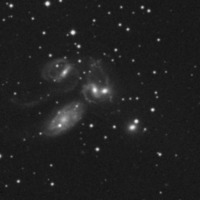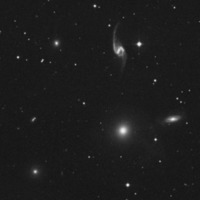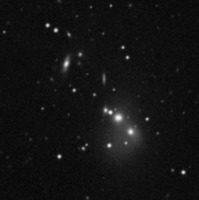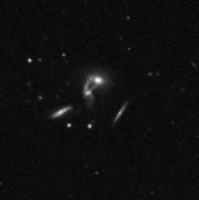Hickson 92 (GxG)

Image source: DSS II (blue) - 7'×7'
|
| Name: |
Hickson 92, HCG92, Arp319, Stephan's Quintet |
| Type: |
GxG |
| Constellation: |
Peg |
| Coordinates: |
22h35m57.50s / +33°57'36.00" |
| Group Members: |
| NGC7317 |
|
13m.6 |
0.7'×0.6' (150°) |
| NGC7318A |
(UGC12099) |
13m.4 |
0.9'×0.9' (90°) |
| NGC7318B |
(UGC12100) |
13m.2 |
1.9'×1.2' (120°) |
| NGC7319 |
(UGC12102) |
13m.5 |
1.7'×1.3' (148°) |
| NGC7320 |
(UGC12101) |
12m.6 |
2.2'×1.1' (132°) |
|
| Robert Zebahl |
4.5" f/8, 60x, Bortle 3, NELM 6m.3+, SQM-L 21.3
A rather difficult group for 4.5 inch. Transparent sky is very important. At 60x I saw a brightening, that includes NGC7318A/B and NGC7320. Separating them was difficult. Only at 100x I could separate both for sure and they appeared as oval nebulas.
|
MODERATE
|
152mm f/5.9, 129x, Bortle 4, SQM-L 21.0
Only the two brightest members were visible. NGC 7320 appeared oval, faint, almost equally bright, NGC 7318A/B also oval, moderately condensed.
|
MODERATE
|
152mm f/8, 171x, Bortle 4, SQM-L 21.2
The two brightest members, NGC 7320 and NGC 7318A/B, were visible quite well with averted vision as faint, oval nebulae. While NGC 7320 appeared rather uniform, NGC 7318A/B showed a slight increase in brightness towards the center. NCG 7317 was only visible as a very compact brightening close to the faint field star and was by no means easy to see. NGC 7319 was not visible.
|
MODERATE
|
8" f/6, 150x, Bortle 4, SQM-L 21.0
Wonderful, but more fainter group near NGC7331. NGC7318A/B appeared at 80x as oval, evenly bright nebula with averted vision and is brightest member. At 214x I could separate the cores of both galaxies with averted vision. NGC7320 was also fairly easily seen at 80x with averted vision, oval, relatively faint. NGC7317 is located nearby a 13.4m star and appeared at 150x as a very compact brightening. NGC7319 is the faintest member in this group and was visible at 150x as an extremely faint glow.
|
MODERATE
|
| René Merting |
12.5" f/4.5, 206x, SQM-L 21.3
NGC 7317: bei 111x als stellare Aufhellung eindeutig sichtbar
NGC 7318 & 7318A: bei 72x beide zusammen als ein Nebelfleck erkennbar - bei 206x dann ist die Trennung sichtbar und die Kerne beider Galaxien blitzen stellar auf
NGC 7319: bei 72x als nebliges Flecken erkennbar - bei 111x die am zweitbesten sichtbare Galaxie, leicht länglich
NGC 7320: bei 72x als schwacher Schimmer auszumachen - bei 111x ist sie die leichteste Galaxie dieser Gruppe mit einer leichten Kondensation südöstlich
|
EASY
|
12.5" f/4.5, 206x, SQM-L 21.3
NGC 7317: bei 111x als stellare Aufhellung eindeutig sichtbar
NGC 7318 & 7318A: bei 72x beide zusammen als ein Nebelfleck erkennbar - bei 206x dann ist die Trennung sichtbar und die Kerne beider Galaxien blitzen stellar auf
NGC 7319: bei 72x als nebliges Flecken erkennbar - bei 111x die am zweitbesten sichtbare Galaxie, leicht länglich
NGC 7320: bei 72x als schwacher Schimmer auszumachen - bei 111x ist sie die leichteste Galaxie dieser Gruppe mit einer leichten Kondensation südöstlich
|
EASY
|
|
Hickson 93 (GxG)

Image source: DSS II (blue) - 12'×12'
|
| Name: |
Hickson 93, HCG93 |
| Type: |
GxG |
| Constellation: |
Peg |
| Coordinates: |
23h15m22.00s / +18°59'30.00" |
| Group Members: |
| NGC7547 |
(UGC12453) |
13m.7 |
1.1'×0.5' (95°) |
| NGC7549 |
(UGC12457) |
13m.0 |
2.8'×0.7' (8°) |
| NGC7550 |
(UGC12456, H3.181) |
12m.2 |
1.4'×1.2' (150°) |
| NGC7553 |
|
14m.4 |
0.7'×0.6' (165°) |
| NGC7558 |
|
14m.9 |
0.4'×0.4' (65°) |
|
| Robert Zebahl |
8" f/6, 96x, Bortle 4-, NELM 5m.7+, SQM-L 20.8
Conditions in the target region: SQM-L 20.6
Largest and brightest member is NGC7550, which was barely visible with direct vision at 96x. This galaxy appeared roundish with slightly brighter center, otherwise rather evenly bright. At 133x the core appeared very compact. Second brightest member is NGC7549, which appeared at 96x roundish, at 133x partly slightly oval. Overall quite faint, but well perceptible with averted vision. The slightly fainter NGC7547 was seen at 96x only as rather compact brightening, at 133x evenly bright. Probably I only saw the brighter core area. The two faintest members 7553 & 7558 I didn't tried until now.
|
MODERATE
|
|
Hickson 94 (GxG)

Image source: DSS II (blue) - 6'×6'
|
| Name: |
Hickson 94, HCG94 |
| Type: |
GxG |
| Constellation: |
Peg |
| Coordinates: |
23h17m16.00s / +18°43'00.00" |
| Group Members: |
| NGC7578A |
(UGC12477, H3.182.1) |
13m.9 |
0.7'×0.6' (90°) |
| NGC7578B |
(UGC12478, H3.182.2) |
14m.0 |
1.7'×1.2' (25°) |
| NGC7578C |
(PGC70936) |
b16m.5 |
0.3'×0.2' |
| PGC70937 |
|
b18m.1 |
0.6'×0.2' |
| PGC70939 |
|
b18m.2 |
0.3'×0.2' |
| PGC70941 |
|
b18m.6 |
0.2'×0.2' |
| PGC70943 |
|
b16m.4 |
0.8'×0.3' |
|
| Robert Zebahl |
8" f/6, 171x, Bortle 4-, NELM 5m.7+, SQM-L 20.8
Conditions in the target region: SQM-L 20.6
The level of difficulty is only related to the two brightest group members (NGC7578A/B). The other members might be too faint for 8 inch aperture. At 66x I could easily see with averted vision around NGC7578A/B a faint, evenly bright glow, which appeared slightly oval at higher magnification. At 171x I could fairly well see within this glow the two rather compact cores of NGC7578 A/B, which were clearly separated from each other. The core of NGC7578 B (northeastern of NGC7578 A) appeared a bit brighter and larger. I didn't looked for the other members of course, but the third brightest one (PGC70943) might be worth trying ;-)
|
MODERATE
|
|
Hickson 95 (GxG)

Image source: DSS II (blue) - 5'×5'
|
| Name: |
Hickson 95, HCG95, Arp150 |
| Type: |
GxG |
| Constellation: |
Peg |
| Coordinates: |
23h19m30.00s / +09°30'00.00" |
| Group Members: |
| MCG+1-59-46 |
(PGC71074) |
b16m.1 |
0.8'×0.2' |
| MCG+1-59-48 |
(PGC71080) |
15m.2 |
0.8'×0.3' |
| NGC7609 |
|
14m.2 |
1.3'×1.1' (60°) |
| PGC71077 |
|
16m.1 |
0.7'×0.4' |
|
| Robert Zebahl |
8" f/6, 171x, Bortle 4-
This observation was a while back and I could only saw NGC7609 as very faint, roundish brightening, but at the limit of perception with averted vision. But don't expect too much from this Hickson/Arp group with 8 inch aperture.
|
DIFFICULT
|
|



